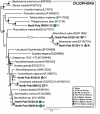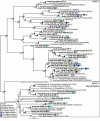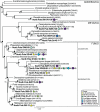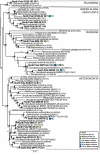Diversity and vertical distribution of microbial eukaryotes in the snow, sea ice and seawater near the north pole at the end of the polar night
- PMID: 21833337
- PMCID: PMC3153057
- DOI: 10.3389/fmicb.2011.00106
Diversity and vertical distribution of microbial eukaryotes in the snow, sea ice and seawater near the north pole at the end of the polar night
Abstract
Our knowledge about the microorganisms living in the high Arctic Ocean is still rudimentary compared to other oceans mostly because of logistical challenges imposed by its inhospitable climate and the presence of a multi-year ice cap. We have used 18S rRNA gene libraries to study the diversity of microbial eukaryotes in the upper part of the water column (0-170 m depth), the sea ice (0-1.5 m depth) and the overlying snow from samples collected in the vicinity of the North Pole (N88°35', E015°59) at the very end of the long polar night. We detected very diverse eukaryotes belonging to Alveolata, Fungi, Amoebozoa, Viridiplantae, Metazoa, Rhizaria, Heterokonta, and Telonemia. Different alveolates (dinoflagellates and Marine Alveolate Groups I and II species) were the most abundant and diverse in gene libraries from water and sea ice, representing 80% of the total number of clones and operational taxonomic units. Only contaminants and/or species from continental ecosystems were detected in snow, suggesting wind- and animal- or human-mediated cosmopolitan dispersal of some taxa. By contrast, sea ice and seawater samples harbored a larger and more similar inter-sample protist diversity as compared with snow. The North Pole was found to harbor distinctive eukaryotic communities along the vertical gradient with an unparalleled diversity of core dinoflagellates, largely dominant in libraries from the water column, as compared to other oceanic locations. In contrast, phototrophic organisms typical of Arctic sea ice and plankton, such as diatoms and prasinophytes, were very rare in our samples. This was most likely due to a decrease of their populations after several months of polar night darkness and to the presence of rich populations of diverse grazers. Whereas strict phototrophs were scarce, we identified a variety of likely mixotrophic taxa, which supports the idea that mixotrophy may be important for the survival of diverse protists through the long polar night.
Keywords: North Pole; alveolates; arctic; dinoflagellates; plankton; protist diversity; sea ice.
Figures








References
-
- Arrigo K. R. (2003). “Primary production in sea ice,” in Sea Ice – An Introduction to its Physics, Chemistry, Biology and Geology, eds Thomas D. N., Dieckmann G. S. (Oxford: Blackwell Publishing; ), 143–183
-
- Behnke A., Barger K. J., Bunge J., Stoeck T. (2010). Spatio-temporal variations in protistan communities along an O/HS gradient in the anoxic Framvaren Fjord (Norway). FEMS Microbiol. Ecol. 72, 89–102 - PubMed
-
- Booth B. C., Horner R. A. (1997). Microalgae on the Arctic Ocean section, 1994: species abundance and biomass. Deep Sea Res. Part II Top. Stud. Oceanogr. 44, 1607–1622
-
- Brierley A. S., Thomas D. N. (2002). Ecology of southern ocean pack ice. Adv. Mar. Biol. 43, 171–276 - PubMed
LinkOut - more resources
Full Text Sources
Molecular Biology Databases
Miscellaneous

